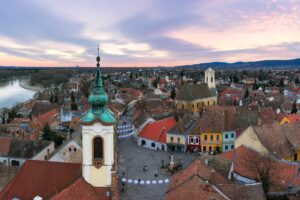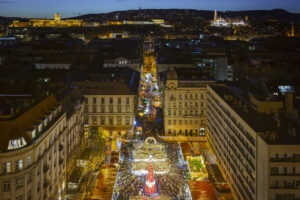For Budapest, 2017 will be the year that a lot of projects that are still in-development will be completed, while others, yearned for a long time by city-dwellers, will finally take off. Let’s see some of the most significant developments of the coming year!
Dagály Swimming Complex
With a height of 44 meters, the grand building of the Dagály Swimming Complex will make for an imposing end-piece to Moszkva sétány, a romantic promenade that will stretch from Dráva utca once finished. The reflecting surfaced complex, seating 20,000 people (thanks to a temporary grandstand to be disassembled after the event), will accommodate the 2017 FINA World Aquatics Championship from 14 to 30 July, and with a little luck, it will also house a few Olympic events come 2024.
HB Reavis
Once the office park of property developer company HB Reavis is all done and dusted, the neighborhood of Árpád híd’s Pest abutment will look like a mini-Manhattan, the many high-rises forming a mid-sized skyline. Works on the office building complex to be built on a 3 hectares large area near the Danube, and containing two 90-meters tall towers, will start in 2017, with the first buildings hopefully completed by 2019.
Párisi Udvar
The Brudern-house, more commonly known as Párisi Udvar, is one of downtown Budapest’s most beautiful buildings – or rather, it will be, once the refurbishment process comes to an end in 2017. The soon-to-be-a-luxuriant-hotel was built in 1913 in the eclectic style (borrowing elements from Moorish and Gothic architecture), famous for its ornate passageway, adorned with Zsolnay ceramics and Miksa Róth’s stained glass windows. After laying empty for more than two decades, the building was bought by a property development company, with the intention of turning it into a 5 star hotel, complete with restaurants, shops and cafés.
Palatinus
The island of Margitsziget has been the home to the city’s favorite lido since the end of World War 1, making the Palatinus the city’s oldest outdoor swimming pool complex. Reconstruction works on its main building (a mesh of Italian Modernism and Bauhaus) have started back in late 2015, with the project’s primary objective to restore the former glory of Palatinus, and to expand its functions. The renewed lido will be finished in March 2017, its wellness and fitness facilities awaiting patrons all year long.
Liget Project
Undeniably the single biggest development currently in Budapest is the (in)famous Liget Project, whose aim is to transform and rejuvenate the unkempt City Park into a well-manicured green oasis of culture, giving home to a collection of museums (both already existing but refurbished and new, modern constructions), with an even larger area of greenery, and added sports facilities. There’s a profound divide in opinions regarding the need for more buildings in one of Europe’s oldest public parks, but everybody agrees that a face-lift has been well-needed for City Park for quite some time now.
Headquarters of MTESZ
The headquarters of MTESZ has long since been an eyesore of Kossuth tér, even more-so after the whole square was refurbished and the Parliament building renovated a couple of years ago. The ugly concrete building was erected in the 70s, and although some architects say it’s an important part of Hungary’s architectural heritage, most of the public thought otherwise. Lucky for us, a dangerous amount of asbestos was found in the structure situated above the Kossuth tér stop of the M2 metro, prompting officials to start tearing down the building, giving the architects of the present day the chance to make amends with the public taste. Two possibilities exist now: in a few years, Kossuth tér will either house a modern, contemporary building, or finally we’ll get architects with some sense in their minds, who will design and build a house more in line with the spirit of stately square.





